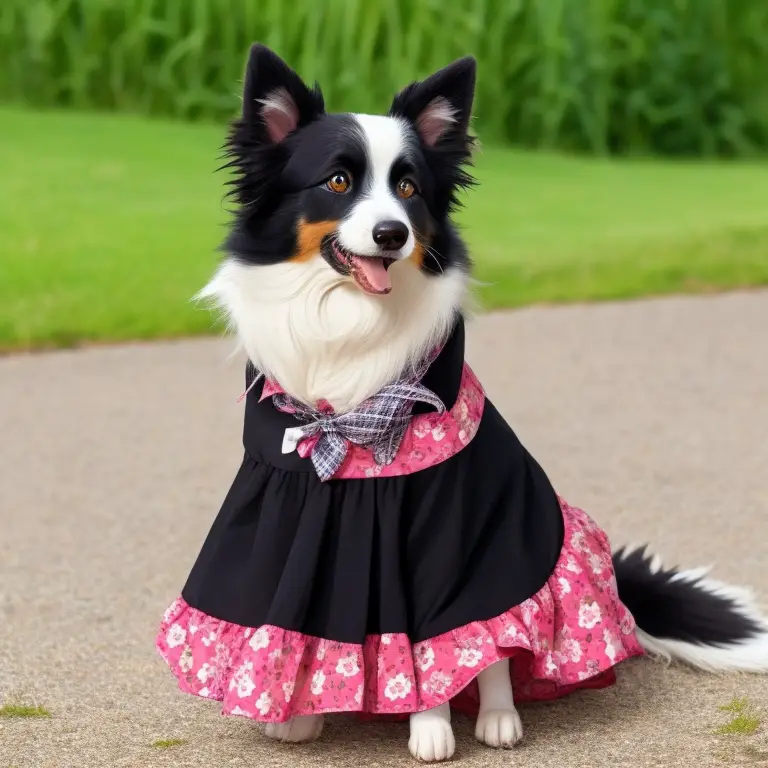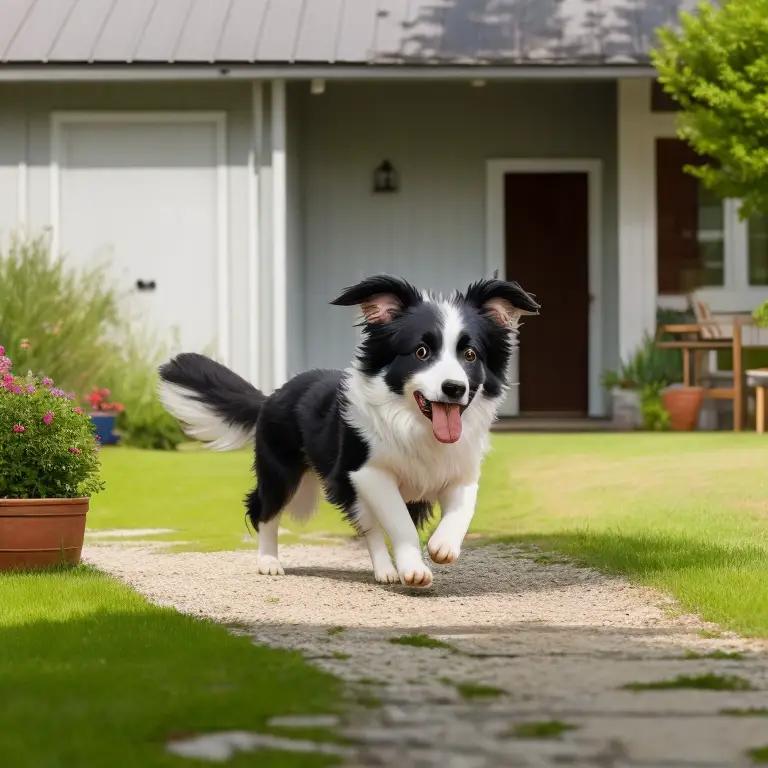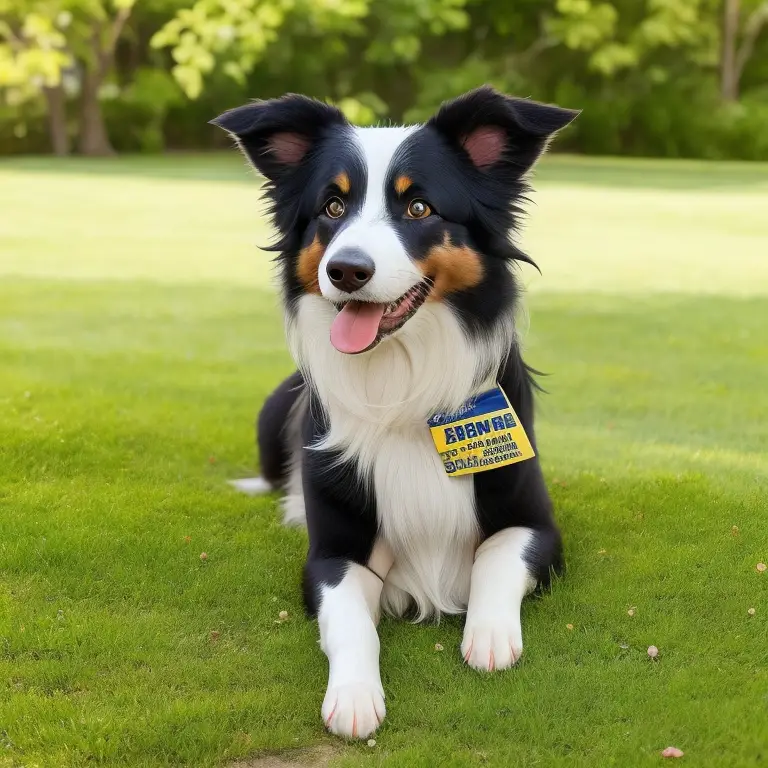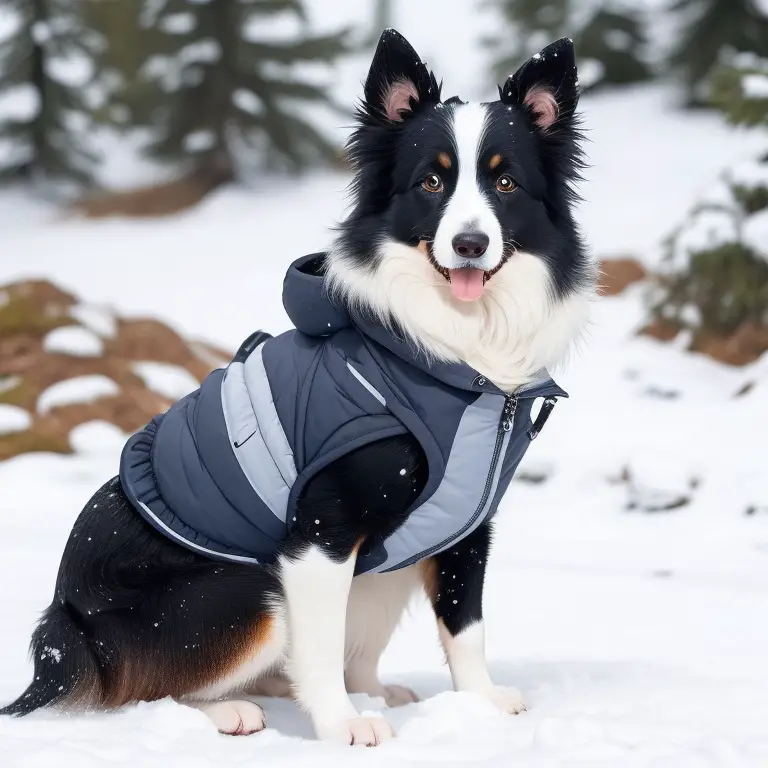How To Teach a Border Collie To Walk Nicely On a Leash?
Are you tired of being pulled down the street by your energetic Border Collie every time you go for a walk? Leash training is essential for the safety and well-being of both you and your furry companion.
But teaching a highly intelligent and active breed like the Border Collie may require some extra effort and patience.
In this article, we’ll explore the unique characteristics of Border Collies that affect leash training, share basic training principles, discuss leash training techniques, and troubleshoot common problems. With consistent training, positive reinforcement, and a little bit of preparation, you can teach your Border Collie to walk nicely on a leash.
| Technique | Pros | Cons |
|---|---|---|
| Positive Reinforcement | Encourages good behavior, strengthens bond between dog and owner | May take longer for some dogs to grasp the concept, requires patience and consistency from the owner |
| Choke Chain | Gives more control over the dog, can be effective for stubborn dogs | Can cause physical harm to the dog if used improperly, can damage the bond between dog and owner |
| Head Collar | Allows for gentle control over the dog, can be effective for dogs prone to pulling | May take some time for the dog to get accustomed to wearing it, may not be suitable for all dogs |
| Clicker Training | Gives instant feedback, can be fun for both dog and owner | May take time to get the timing right, requires consistency and patience from the owner |
| Backpack Method | Provides extra weight to help burn energy, can help the dog focus and learn to walk nicely | May not work for all dogs, backpack must be of appropriate size and weight |
Understanding Border Collies’ Needs and Behaviors
Why Border Collies Need Proper Leash Training
Border Collies are highly intelligent and active dogs that require a lot of exercise to remain healthy and happy. Most Border Collies love going for walks, but without proper leash training, they can become unruly and difficult to control.
This breed of dog has a strong herding instinct and a high prey drive, making them prone to chasing after other animals and running off.
A Border Collie that is not properly leash trained can create an unsafe situation for themselves and others. Proper leash training not only ensures the safety of the dog and people around them but also strengthens the bond between the dog and its owner.
Border Collie’s Characteristics That Affect Leash Training
Border Collies are intelligent and energetic dogs that make excellent companions. However, their traits also affect their leash training.
Here are Border Collie’s characteristics that affect leash training:
- High Energy Levels: Border Collies are high-energy dogs and require plenty of exercise. Without physical and mental stimulation, they can become restless and anxious, which can affect leash training.
- Herding Instincts: Border Collies have a strong herding instinct due to their breeding history. As a result, they are prone to chase and nip at moving objects, including other animals and people. It’s important to train them to control their impulses and not pull on the leash.
- Intelligence: Border Collies are highly intelligent dogs that quickly learn and respond to commands. However, this also means they can easily get bored with repetitive training exercises. Keep their training sessions varied and exciting to maintain their attention and interest.
- Independence: Despite their loyalty and obedience, Border Collies can also exhibit independence and stubbornness. Therefore, it’s important to establish your role as the pack leader and enforce consistent training and rules to maintain their attention and obedience.
Understanding these Border Collie’s characteristics that affect leash training is crucial to developing effective training strategies for your furry friend. With the right training techniques and consistent practice, you can teach your Border Collie to walk nicely on a leash.
Basic Training Principles for Border Collies
To teach a Border Collie to walk nicely on a leash, it’s crucial to understand their basic training principles. Border Collies are highly intelligent and energetic dogs that require daily physical activity and mental stimulation.
Here are some basic training principles to follow when teaching leash manners to your Border Collie:
- Start early: Begin training your puppy as soon as you bring them home. This helps establish good habits and prevent bad ones.
- Positive reinforcement: Use positive reinforcement techniques like treats, praise, and play to reinforce good behavior and help your dog learn.
- Consistency: It’s essential to be consistent with training cues and consequences, so your dog knows what to expect.
- Patience: Remember, training takes time, and progress comes in small steps. Don’t expect your dog to learn everything at once.
By following these principles, you can establish good habits and behaviors in your Border Collie and build a strong bond with them.
Preparing for Leash Training
Choosing the Right Equipment
When choosing equipment for leash training your Border Collie, the two most popular options are collars and harnesses. Collars are a simple option, but they can be harsh on your dog’s neck and throat, especially if they pull.
On the other hand, harnesses distribute the pressure evenly across your dog’s body, reducing the risk of injury.
There are several types of harnesses available, including front-clip harnesses, back-clip harnesses, and headcollars. Front-clip harnesses have a clip that attaches to the front of your dog’s chest, which helps to discourage pulling.
Back-clip harnesses have a clip on the back, which makes them more suitable for well-trained dogs.
Headcollars are often used for stronger, more stubborn dogs, as they provide greater control. When selecting a leash, a standard leash or a retractable leash is a good option.
Standard leashes come in a variety of lengths and thicknesses and are suitable for most dogs.
Retractable leashes allow your dog more freedom to explore while still remaining in your control, but they can be dangerous if not used correctly. Overall, it is best to choose equipment that is both safe and comfortable for your Border Collie.
Consider your dog’s size, strength, and behavior when selecting equipment.
With the right equipment, you can make leash training a positive experience for both you and your furry friend.

Setting Training Goals
Setting training goals is an essential step in preparing for leash training with your Border Collie. It involves identifying what behaviors you want to teach your dog and the specific skills required to achieve them.
To start, consider what a successful leash walk looks like for you and your furry friend.
Do you want your Border Collie to walk beside you calmly or be able to walk off-leash without running away? Once you have this vision in mind, break it down into smaller, achievable goals that you can work on with your dog.
It’s also important to keep in mind that every Border Collie is unique, and each will have their own challenges and strengths when it comes to leash training.
As you set your goals, take into account your dog’s individual temperament, energy level, and learning style. When setting training goals, remember to keep them realistic and achievable.
Focusing on small successes builds momentum and keeps both you and your dog motivated to continue training.
With patience and consistency, your Border Collie will soon be a pro at walking nicely on a leash.

Creating a Positive Training Environment
Creating a positive training environment is crucial when preparing for leash training your Border Collie. Here are some tips to ensure a positive learning experience:
- Use positive reinforcement techniques such as treats, praise, and toys to motivate your Border Collie.
- Avoid using punishment or harsh training methods, as they can damage your dog’s trust and confidence.
- Choose a location that is quiet and free from distractions, such as other dogs or traffic.
- Set short and achievable training goals, gradually increasing the distance and duration of walks as your Border Collie learns.
- Be patient, consistent, and encouraging in your training approach.
By creating a positive training environment, you will build a strong foundation for successful leash training with your Border Collie.
Leash Training Techniques
Starting with Basic Commands
When teaching your Border Collie to walk nicely on a leash, starting with basic commands is essential. These commands include ‘sit,’ ‘stay,’ and ‘come.’ The sit command is helpful in getting your dog to relax and focus before walking on a leash.
To teach this command, stand in front of your dog with a treat in your hand, and then say ‘sit’ while raising the treat above your dog’s head.
As their head goes up, their bottom should go down. Make sure to reward your dog with the treat when they sit.
The stay command helps you control your dog’s movement while they are on the leash.
Begin by commanding your dog to ‘sit,’ and then move a small distance away. Say ‘stay’ and then return to your dog.
If they remain sitting, reward them with a treat.
The come command is crucial for leash training as it enables you to call your dog to return to your side. Encourage your dog to come when you call their name and praise them when they do.
With consistent training and positive reinforcement, your dog will become comfortable with basic commands and learn how to walk nicely on a leash.
Sit Command
When it comes to teaching your Border Collie to walk nicely on a leash, the “sit” command is an essential part of the training process. Teaching your dog to sit will not only encourage good leash manners, but it can also be a helpful tool in managing your dog’s behavior.
To begin teaching your Border Collie to sit on command, start by holding a treat in your hand and bringing it up to your dog’s nose.
Slowly lift the treat above your dog’s head, causing them to naturally sit to see the treat. As soon as your dog sits, immediately give them the treat and verbal praise like “good sit.” Repeat this process a few times, gradually reducing the amount of time it takes for your dog to sit and removing the treat from your hand.
Verbal cues like “sit” can be introduced at this point, but it’s important not to use the cue until your dog has successfully sat on their own.
Consistency is key when teaching your Border Collie to sit. Practice the command in different environments, with different distractions, and varying durations.
Always reward correct behavior and never punish your dog for not responding as desired.
Overall, the “sit” command is a crucial component of leash training your Border Collie. With patience, consistency, and positive reinforcement, your dog will soon learn to sit on command, making your walk times both enjoyable and well-managed.

Stay Command
When it comes to the Stay command during leash training, the goal is for your Border Collie to remain in one place. This can be especially helpful in situations when you need your dog to stay put, like waiting to cross the street or when greeting strangers.
To begin teaching your Border Collie the Stay command, start by giving the Sit command.
Once your dog is in a seated position, hold up your hand with the palm facing your dog and say “Stay” firmly. Take a small step back and if your dog remains sitting, praise them immediately with “good job.” If your dog tries to stand up or move, say “nope” or “eh-eh” firmly and gently guide them back into a seated position.
Repeat the Stay command and take a small step back.
Practice this exercise in short sessions, gradually increasing the distance and duration of the Stay command. As with any other training technique, always use positive reinforcement.
Reward your dog with treats, praise, and attention whenever they successfully perform the Stay command.
With patience and persistence, your Border Collie will learn to stay in place, making leash training and everyday life easier.
Come Command
When it comes to teaching your Border Collie the “Come Command,” consistency and positive reinforcement are key. Start in a quiet area where there are minimal distractions and say your dog’s name followed by the command “Come.” When your dog comes to you, reward them with praise and treats.
Gradually increase the distractions, such as calling them from another room or when they are playing with a toy.
Remember to always reward them when they come to you, even if it takes a bit longer than expected. Avoid using negative reinforcement or punishment if your dog doesn’t come to you right away.
This can harm the bond between you and your dog and decrease their willingness to obey your commands.
Consistently practicing the “Come Command” and rewarding positive behavior will help your Border Collie understand the importance of returning to you on command and make leash training more enjoyable for both you and your pup.

Positive Reinforcement Training
Leash training your Border Collie with positive reinforcement is one of the most effective ways to teach him to walk nicely on a leash. Positive reinforcement involves rewarding your dog for good behavior, which encourages him to repeat that behavior in the future.
There are various positive reinforcement techniques you can use, such as using a clicker or treat-based training.
Clicker training involves using a clicker to make a particular sound, and then immediately following it up with a treat to reward your dog for good behavior. Treat-based training involves giving your Border Collie a treat every time he behaves well on the leash.
When using these positive reinforcement techniques, it’s essential to choose high-value treats that your dog loves.
This includes treats like chicken, beef, or even small slices of cheese. However, it’s crucial to ensure that you’re not overfeeding your Border Collie, as too many treats can lead to weight gain and other health problems.
Overall, positive reinforcement training is a powerful technique that can be used to teach your Border Collie how to walk nicely on a leash.
By rewarding your dog for good behavior, you’ll gradually encourage him to repeat that behavior in the future, leading to better leash manners and a happier, healthier dog.

Clicker Training
Clicker training is a method of operant conditioning that is highly effective in teaching dogs new behaviors. With this technique, a clicker is used to mark the exact moment when a dog performs a desired behavior, followed by a treat as a reward.
This helps the dog understand the exact behavior that is being reinforced.
To start clicker training, first, choose a specific behavior that you want your Border Collie to learn, such as sitting or staying in a particular position. Use the clicker to mark the exact moment each time your dog performs the desired behavior.
Immediately after the click, offer a small treat as a reward.
With repeated training sessions, your Border Collie will learn to associate the sound of the click with getting a reward for performing the desired behavior. Clicker training is a highly effective, positive reinforcement training technique for dogs.
It engages the dog’s natural curiosity and desire for a reward, making it an enjoyable experience for both you and your Border Collie.
Treat-Based Training
Treat-Based Training is a popular positive reinforcement approach that rewards good behavior with treats. The idea behind it is to motivate your Border Collie to learn and obey leash commands through a reward system.
This technique is perfect for Border Collies who love food and enjoy pleasing their owners.
To get started with Treat-Based Training, choose a high-value treat that your dog will be excited to receive. When out for a walk or training exercise, give your Border Collie a treat every time they exhibit good behavior like walking calmly by your side, sitting when you stop, or heeling properly.
Ensure you don’t overuse this technique as your dog may become overly dependent on treats.
Gradually reduce the number of treats as your dog gets better at leash walking. Make sure to combine positive reinforcement techniques with verbal praise and affectionate touches for optimal effect.
Treat-based Training is an effective way to positively reinforce good leash habits in your Border Collie.
Ensure it is combined with other training techniques and used responsibly to reduce dependency on treats. Remember, your furry friend wants to please you, and consistent practice will yield excellent results.

Correcting Leash Pulling Behaviors
Correcting leash pulling in Border Collies can be a challenging but necessary part of their leash training. Let’s explore some techniques that can help manage this behavior effectively.
Stopping and redirecting is a simple and effective way to correct leash pulling.
When your Border Collie starts pulling, stop walking immediately and wait until they stop pulling. Then, redirect your dog’s attention to a different direction by using a treat or a toy.
Repeat this process until your dog learns to walk next to you on a loose leash.
Another technique to correct leash pulling is to use a gentle leader or a front-clip harness. These tools allow you to have more control over your dog’s head and body, making it difficult for them to pull.
However, it’s important to note that these tools should be used in conjunction with proper training and should not be relied upon as a substitute for effective training.
Consistency is key when correcting leash pulling behaviors. Ensure that all members of the family who walk your Border Collie are using the same techniques.
Reward your dog for good behavior and be patient when correcting bad behavior.
Positive reinforcement is always the preferred method when training your dog and will lead to long-lasting results. Correcting leash pulling behaviors in Border Collies requires patience, consistency, and positive reinforcement.
Incorporating proper training techniques and using the appropriate tools can help manage leash pulling behaviors effectively.
Stopping and Redirecting
Stopping and redirecting are important techniques when training a Border Collie to walk nicely on a leash. When your dog starts to pull, abruptly stop and call your dog back to you.
Once your dog returns and relaxes, resume walking.
Redirect your dog’s attention onto yourself by giving treats or verbal praises. Be patient and consistent in practicing these techniques.
Avoid using physical force as it can lead to more behavioral problems.
With consistent training, your Border Collie will learn to walk nicely on a leash and enjoy daily walks with you.

Using a Gentle Leader or Front-Clip Harness
Leash pulling is a common problem for dogs, including Border Collies. Using a Gentle Leader or Front-Clip Harness can help correct this behavior.
These tools work by redirecting your dog’s attention towards you while walking, rather than pulling on the leash.
A Gentle Leader is a head collar that fits over the dog’s nose. When the dog pulls, the halter gently guides their head towards you, making it harder for them to pull.
A Front-Clip Harness is a harness with a front-clip attachment, which allows you to attach the leash to the front of your dog’s chest.
When the dog pulls, it turns their body towards you, reducing their ability to pull forward. Both of these tools can be effective for leash training, but it’s important to introduce them slowly and positively.
You should never jerk or pull on the leash while using either of these tools.
Instead, use positive reinforcement techniques to encourage good behavior. Always monitor your dog while using a Gentle Leader or Front-Clip Harness, as improper use can cause discomfort or harm.
When used correctly, these tools can be effective in teaching your Border Collie to walk nicely on a leash.

Maintaining Good Leash Manners
Consistency is Key
Consistency is key when it comes to maintaining good leash manners in your Border Collie. This means that you need to be consistent in your training approach and ensure that everyone who interacts with your dog is on the same page.
Inconsistency can lead to confusion, frustration, and even regression in your dog’s training progress.
When teaching your Border Collie to walk nicely on a leash, make sure to use the same commands, rewards, and correction techniques every time. Stick to a regular training schedule and remain patient.
Remember that training takes time, and your dog may need frequent reminders to stay on track.
It’s also crucial to practice good leash manners even outside of training sessions. Always enforce the same rules when walking your dog, whether you’re in a familiar or new environment.
Consistency will help build good habits and reinforce positive behaviors.
Maintaining consistency requires dedication but is well worth the effort. Your Border Collie will feel more confident and secure, and you’ll have a better bond with your furry companion.

Regular Exercise and Playtime
Regular exercise and playtime are crucial for maintaining good leash manners in your Border Collie. This breed is highly energetic and needs an outlet to release that energy.
A tired dog is a well-behaved dog, so make sure your Border Collie has daily opportunities to run and play.
A daily walk is a great start for exercise, but it’s not enough for a Border Collie. They need more physical activity, such as running, playing fetch, or agility training to keep them mentally and physically stimulated.
Playing with your Border Collie is also important.
Engage them in interactive games like tug-of-war or hide-and-seek to strengthen your bond and stimulate their mind. Remember to match the exercise level to your dog’s age and fitness level, and always provide access to fresh water during and after playtime.
Regular exercise and playtime are essential for your Border Collie’s overall health and well-being, and for developing good leash manners.
So get outside and have some fun with your furry friend!
Continuing to Reinforce Positive Behaviors
Now that you’ve trained your Border Collie to walk nicely on a leash, it’s important to continue reinforcing positive behaviors to maintain good leash manners. Consistency is key in reinforcing good behavior.
Always reward your dog for walking beside you calmly and not pulling on the leash, while also redirecting and correcting any pulling behavior.
Regular exercise and playtime can also help reduce your dog’s energy levels and prevent over-excitability during walks. A tired dog is generally more responsive to training and less likely to pull on the leash.
It’s important to remember that training is an ongoing process and to continue practicing leash training techniques regularly.
Incorporating training into everyday walks and outings will help reinforce positive behaviors and cement good leash manners in your Border Collie.
Troubleshooting Common Leash Training Problems
Fear and Anxiety
Fear and anxiety are common issues that can arise during leash training of Border Collies. These issues can manifest in different ways, such as panting, pacing, or even freezing.
If your Border Collie displays any signs of fear or anxiety, it’s important to address the issue before proceeding with further training.
To help minimize fear and anxiety, it’s vital to create a positive training environment by rewarding good behavior and being patient with your dog. You can also try taking training sessions slow, gradually exposing your dog to new sights and sounds, and offering plenty of positive reinforcement.
If your Border Collie is displaying significant levels of fear or anxiety, it may be necessary to seek the help of a professional trainer who uses positive reinforcement techniques.
With their guidance, you can address the underlying causes of your Border Collie’s fears and anxieties and help your dog become a master on the leash.
Aggression Towards People or Other Dogs
Aggression towards people or other dogs is a common issue that Border Collies may exhibit during leash training. To address this problem, try the following:
- Socialization: Expose your Border Collie to new people, environments, and other dogs to promote positive reactions and prevent fear-based aggression.
- Behavior Modification: Consulting a professional dog trainer or behaviorist can assist in identifying underlying triggers, devising behavior modification strategies, and reinforcing positive behaviors.
- Positive Reinforcement: Reward your Border Collie’s good behavior with praise, treats, and affection to associate positive experiences with people and other dogs.
- Consistent Training: Maintaining consistency in your training technique, rules, and boundaries can provide structure and clarity for your Border Collie, promoting positive behavior and discouraging aggression.
Remember, aggression towards people or other dogs is not to be taken lightly. Take the necessary steps to ensure your Border Collie’s safety and happiness during leash training.

Over-Excitability
Over-excitability is a common issue for Border Collies during leash training. These dogs are known for their high energy and eagerness to explore their environment.
However, this quality can also make them easily distracted and lead to pulling on the leash.
To reduce over-excitability, try to tire your Border Collie out with physical exercise or mental stimulation before starting training. You can also use a calm tone of voice and positive reinforcement to help focus their attention and encourage good behavior.
Additionally, using a front-clip harness or a gentle leader can provide some extra control during training.
Remember, consistent training and patience are key to overcoming over-excitability in Border Collies during leash training.

Conclusion
Teaching your Border Collie to walk nicely on a leash requires patience, consistency, and a deep understanding of their unique needs and behaviors. By choosing the right equipment, setting clear goals, and using positive reinforcement techniques, you can help your furry friend become a confident and well-behaved walking companion.
Remember to maintain regular exercise and playtime, and to continue reinforcing positive behaviors to ensure long-term success.
With these tips in mind, you can confidently embark on the rewarding journey of leash training your beloved Border Collie.







